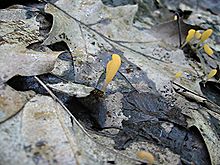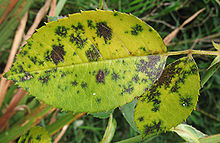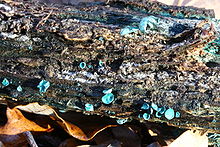- Helotiales
-
Helotiales 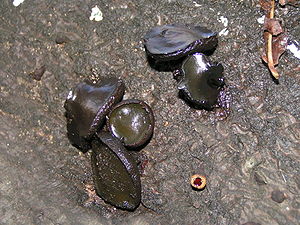
Gemeiner Schmutzbecherling Bulgaria inquinans, Fruchtkörper
Systematik ohne Rang: Opisthokonta Reich: Pilze (Fungi) Abteilung: Schlauchpilze (Ascomycota) Unterabteilung: Echte Schlauchpilze (Pezizomycotina) Klasse: Leotiomycetes Ordnung: Helotiales Wissenschaftlicher Name Helotiales Nannf. Die Helotiales sind eine Ordnung der Schlauchpilze. Sie sind morphologisch sehr vielfältig, daher werden einzelne Merkmale bei den Familien angeführt. Bekannte Vertreter sind die Grauschimmel (Botrytis).
Inhaltsverzeichnis
Lebensweise
Die Vertreter der Helotiales leben als Pflanzenpathogene, Endophyten, Nematophage Pilze, Mykorrhiza-bildende Pilze, als Pilz-Parasiten, als terrestrische und aquatische Saprobionten.
Systematik
Die Vertreter der Helotiales sind eindeutig keine natürliche Verwandtschaftsgruppe, sie sind paraphyletisch. Eine Aufteilung in mehrere monophyletische Ordnungen in nächster Zeit gilt als wahrscheinlich.[1] Eriksson 2006 führt für die Helotiales folgende Familien (mit ausgewählten Gattungen und Arten) an:[2] Die Geoglossaceae gehören nach Wang et al. nicht mehr zu den Helotiales. Sie werden neuerdings in eine eigene Klasse, die Geoglossomycetes gestellt.[3]
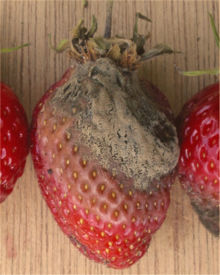 Grauschimmelfäule (Botrytis cinerea) auf Erdbeere.
Grauschimmelfäule (Botrytis cinerea) auf Erdbeere.
- Bulgariaceae mit einziger Gattung
- Bulgaria mit nur einer Art: Sie bildet braunschwarze bis schwarze, gallertige Apothecien.
- Dermateaceae mit 77 Gattungen: Endophyten. Heterogene, kaum untersuchte Familie. Sie bilden kleine fleischige Apothecien auf Pflanzen. Das Excipulum besteht aus dickwandigen runden bis eckigen Zellen. Ziemlich sicher nicht monophyletisch.
- Blumeriella
- Calloria
- Chlorosplenium
- Cryptohymenium
- Dermateopsis
- Drepanopeziza
- Involucroscypha
- Leptotrochila
- Obscurodiscus
- Trochila
- Helotiaceae mit 94 Gattungen: Die Familie ist nach Wang et al. 2006 polyphyletisch und bildete in deren Studie acht Kladen.
- Bulgariella
- Chlorociboria
- Crumenella
- Erikssonopsis
- Hymenoscyphus
- Ombrophila
- Strossmayeria
- Unguiculariopsis
- Xylogramma
- Hemiphacidiaceae mit fünf Gattungen: Die Vertreter sind Pathogene an Pflanzenblättern und bilden kleine einfache Apothecien unter der Blattoberfläche, die sie während des Wachstums durchstoßen.
- Sarcotrochila
- Hyaloscyphaceae mit 68 Gattungen:
- Belonidium
- Betulina
- Clavidisculum
- Lachnum
- Olla
- Proliferodiscus
- Unguicularia
- Leotiaceae mit fünf Gattungen
- Gelatinipulvinella
- Leotia
- Neobulgaria
- Loramycetaceae mit einziger Gattung
- Loramyces : sie leben aquatisch
- Phacidiaceae mit drei Gattungen
- Rutstroemiaceae mit fünf Gattungen
- Poculum
- Rutstroemia
- Sclerotiniaceae mit 34 Gattungen: Pflanzenendophyten und -pathogene, sie bilden sklerotisierte Fruchtkörper.
- Asterocalyx
- Ciboria
- Mitrula
- Phaeosclerotinia
- Sclerotinia
- Vibrisseaceae mit drei Gattungen: sie leben teilweise aquatisch
- Vibrissea
- Ascocorticiaceae mit einziger Gattung
- Ascocorticium
Die Familien Hemiphadiaceae, Rutstroemeriaceae und Sclerotiniaceae bilden nach Wang et al. eine gut abgesicherte monophyletische Gruppe. Die Autoren schlagen die Bildung einer eigenen Ordnung vor.
Quellen
Literatur
- Zheng Wang et al.: Toward a phylogenetic classification of the Leotiomycetes based on rDNA data. In: Mycologia. Band 98, 2006, S. 1065-1075.
Einzelnachweise
- ↑ Wang et al: Toward a phylogenetic classification of the Leotiomycetes based on rDNA data,2006.
- ↑ O. E. Eriksson (Hrsg.): Outline of Ascomycota - 2006 In: Myconet, Band 12, 2006, S. 1-82. (online html)
- ↑ Schoch CL, Wang Z, Townsend JP, Spatafora JW, 2009. Geoglossomycetes cl. nov., Geoglossales ord. nov. and taxa above class rank in the Ascomycota Tree of Life. Persoonia 22, 129-138.[1]
Weblinks
 Commons: Helotiales – Sammlung von Bildern, Videos und Audiodateien
Commons: Helotiales – Sammlung von Bildern, Videos und Audiodateien - Bulgariaceae mit einziger Gattung
Wikimedia Foundation.

